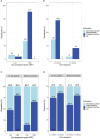Educational level-dependent melanoma awareness in a high-risk population in Switzerland
- PMID: 37207151
- PMCID: PMC10189064
- DOI: 10.3389/fonc.2023.1174542
Educational level-dependent melanoma awareness in a high-risk population in Switzerland
Abstract
Introduction: The worldwide incidence of melanoma has been increasing rapidly in recent decades with Switzerland having one of the highest rates in Europe. Ultraviolet (UV) radiation is one of the main risk factors for skin cancer. Our objective was to investigate UV protective behavior and melanoma awareness in a high-risk cohort for melanoma.
Methods: In this prospective monocentric study, we assessed general melanoma awareness and UV protection habits in at-risk patients (≥100 nevi, ≥5 dysplastic nevi, known CDKN2A mutation, and/or positive family history) and melanoma patients using questionnaires.
Results: Between 01/2021 and 03/ 2022, a total of 269 patients (53.5% at-risk patients, 46.5% melanoma patients) were included. We observed a significant trend toward using a higher sun protection factor (SPF) in melanoma patients compared with at-risk patients (SPF 50+: 48% [n=60] vs. 26% [n=37]; p=0.0016). Those with a college or university degree used a high SPF significantly more often than patients with lower education levels (p=0.0007). However, higher educational levels correlated with increased annual sun exposure (p=0.041). Neither a positive family history for melanoma, nor gender or Fitzpatrick skin type influenced sun protection behavior. An age of ≥ 50 years presented as a significant risk factor for melanoma development with an odd's ratio of 2.32. Study participation resulted in improved sun protection behavior with 51% reporting more frequent sunscreen use after study inclusion.
Discussion: UV protection remains a critical factor in melanoma prevention. We suggest that melanoma awareness should continue to be raised through public skin cancer prevention campaigns with a particular focus on individuals with low levels of education.
Keywords: awareness; education; melanoma; prevention; sunscreen.
Copyright © 2023 Mueller, Goessinger, Cerminara, Kostner, Amaral, Huber, Passweg, Moreno, Bodenmann, Kunz, Levesque, Maul, Cheng, Navarini and Maul.
Conflict of interest statement
AM has received support for conference attendance from ALK, Bencard and Galderma. LK has received speaking fees in a presentation sponsored by Boehringer Ingelheim. ML has project-specific research funding from Roche, Novartis, Molecular Partners, and Oncobit AG and has received speaking fees from Danaher. J-TM is and has served as advisor and/or received speaking fees and/ or participated in clinical trials sponsored by AbbVie, Almirall, Amgen, BMS, Celgene, Eli Lilly, LEO Pharma, Janssen-Cilag, MSD, Novartis, Pfizer, Pierre Fabre, Roche, Sanofi, UCB. AN declares being a consultant and advisor and/or receiving speaking fees and/or grants and/or served as an investigator in clinical trials for AbbVie, Almirall, Amgen, Biomed, Bristol Myers Squibb, Boehringer Ingelheim, Celgene, Eli Lilly, Galderma, GlaxoSmithKline, LEO Pharma, Janssen-Cilag, MSD, Novartis, Pfizer, Pierre Fabre Pharma, Regeneron, Sandoz, Sanofi, and UCB. LM has served as advisor and/or received speaking fees and/or participated in clinical trials sponsored by Almirall, Amgen, BMS, Celgene, Eli Lilly, MSD, Novartis, Pierre Fabre, Roche and Sanofi. The remaining authors declare that the research was conducted in the absence of any commercial or financial relationships that could be construed as a potential conflict of interest.
Figures




Similar articles
-
Knowledge about Ultraviolet Radiation Hazards and Tanning Behavior of Cosmetology and Medical Students.Acta Dermatovenerol Croat. 2016 Apr;24(1):73-7. Acta Dermatovenerol Croat. 2016. PMID: 27149135
-
Do Athletes Practicing Outdoors Know and Care Enough About the Importance of Photoprotection?Acta Dermatovenerol Croat. 2020 Jul;28(1):41-42. Acta Dermatovenerol Croat. 2020. PMID: 32650851
-
Influence of age, gender, educational level and self-estimation of skin type on sun exposure habits and readiness to increase sun protection.Cancer Epidemiol. 2013 Apr;37(2):127-32. doi: 10.1016/j.canep.2012.12.006. Epub 2013 Jan 5. Cancer Epidemiol. 2013. PMID: 23295002
-
Sunscreens in the United States: Current Status and Future Outlook.Adv Exp Med Biol. 2020;1268:355-379. doi: 10.1007/978-3-030-46227-7_18. Adv Exp Med Biol. 2020. PMID: 32918228 Review.
-
Promoting prevention and early recognition of malignant melanoma.Dermatol Nurs. 2009 May-Jun;21(3):115-22; quiz 123. Dermatol Nurs. 2009. PMID: 19554842 Review.
Cited by
-
Awareness of Melanoma and Skin Self-Examination at a Tertiary Care Hospital in Pakistan: A Study of Knowledge, Attitudes, and Practices.Cureus. 2024 Nov 22;16(11):e74251. doi: 10.7759/cureus.74251. eCollection 2024 Nov. Cureus. 2024. PMID: 39717322 Free PMC article.
-
A Comprehensive Analysis of Skin Cancer Concerns and Protective Practices in Manitoba, Canada, Highlights Lack of Skin Cancer Awareness and Predominance of High-Risk Sun Exposure Behaviors.Cancers (Basel). 2024 Sep 5;16(17):3093. doi: 10.3390/cancers16173093. Cancers (Basel). 2024. PMID: 39272952 Free PMC article.
-
The intersection of melanoma survival and social determinants of health in the United States: A systematic review.JAAD Int. 2024 Aug 2;17:126-138. doi: 10.1016/j.jdin.2024.07.006. eCollection 2024 Dec. JAAD Int. 2024. PMID: 39399338 Free PMC article. Review.
-
Clinical Experience of Stereotactic Radiosurgery at a Linear Accelerator for Intraocular Melanoma Combined with Iridociliary Tumor Resection: A Case Report.Case Rep Ophthalmol. 2024 Jan 3;15(1):1-7. doi: 10.1159/000535129. eCollection 2024 Jan-Dec. Case Rep Ophthalmol. 2024. PMID: 38179149 Free PMC article.
-
Avoiding Cutaneous Melanoma Requires Proper Sun Protection and a Correspondingly High Level of Education: A Case Control Study.J Cosmet Dermatol. 2025 Feb;24(2):e16677. doi: 10.1111/jocd.16677. Epub 2024 Dec 10. J Cosmet Dermatol. 2025. PMID: 39658852 Free PMC article.
References
LinkOut - more resources
Full Text Sources
Miscellaneous

